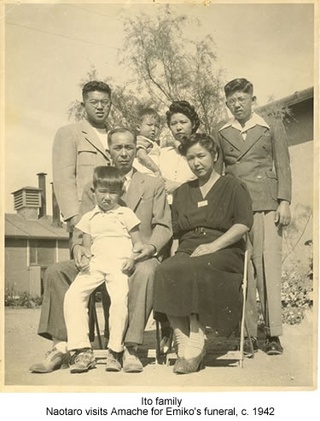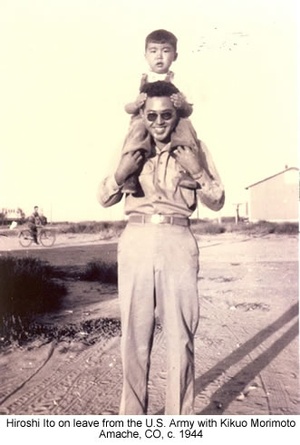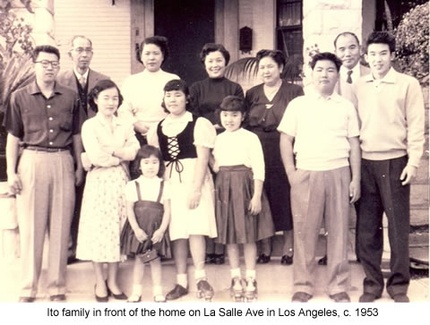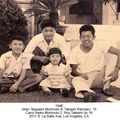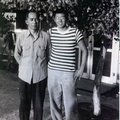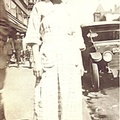>> Part 2
In the morning of Sunday, December 7, 1941, the family heard radio reports of the Japanese attack on Pearl Harbor but went about carrying on as usual not realizing what profound effect this event would have on their lives. Not knowing what else to do, Emi and Takeshi walked to the movie theatre at Washington Boulevard and Vermont Avenue to see the afternoon show. When they returned, the family was about ready to have dinner.
After dinner, Hiroshi, Emi and Takeshi listened to the radio and did homework for the following day. Tsuruko and Naotaro read before going to bed at nine. At eleven thirty two plain clothes police officers came and arrested Naotaro and confiscated a small unloaded handgun he had acquired years ago for security when he was in the hotel business. The family would not see him again until November 1942, when he was given leave from Camp Livingston, Louisiana, to attend Emi’s funeral.
After his arrest, he was first taken to the Central Jail in Los Angeles, then sent to an internment camp at Missoula, Montana, after which he was sent to Fort Bliss, Oklahoma and finally to Camp Livingston. As a condition of his leave to Amache, Colorado where the rest of his family had been sent, he had to agree to pay for the passage of two armed guards from the Army to accompany him to and from Amache.
Emi had become ill at Santa Anita Assembly Center, Arcadia, California from her weakened heart as a result of the previous rheumatic fever and the strain of camp life. She was sent to the General Hospital in Los Angeles and died alone from heart failure after the rest of the family was sent to Amache. Takeshi recalled the one and only visit his mother, Hiro, and he made to the General Hospital before leaving for Amache in which he felt a deep sense of foreboding that this was the final farewell to Emi.
They received word of Emi’s passing within a month after arrival in Amache. This was a very devastating loss for the family. The arrival of Emi’s ashes and the funeral procession with Hiro carrying her ashes with the family and friends following to the makeshift Buddhist temple barrack to the service is indelibly remembered by Takeshi who was thirteen at the time.
In Amache and at Santa Anita, fortunately Yoneko and her family lived close by so Tsuruko could always count her and her husband, Mon, for support in time of need. At that time the Morimotos had two young sons, Masashi (Allen) and Kikuo (Bob). They were blessed with a daughter, Reiko(Carol) before they left Amache when the war ended in 1945.
Hiro graduated from Amache High School in June 1943 and went to New York City in September that same year to attend NYU. After completing his freshman year, he received a draft notice and returned to Amache to await induction into the Army. He was inducted in the fall of 1944 and received his basic training at Camp Blanding, Florida. Subsequently he was chosen to receive training in the Japanese language school at Fort Snelling, Minnesota in preparation to become an interpreter. He completed the training and was on board a troop ship going to the South Pacific when the war ended in September 1945.
His ship proceeded to Manila in the Philippines and he was assigned as an interpreter at the war crimes trial for General Yamashita. Following the trial, he was sent to Tokyo as part of the occupation forces. Hideko with her family had relocated to Tokyo from Matsuyama so Hiro took the first opportunity to see her for the first time since 1927 when he was only five. Hideko and her children can clearly remember that day when he first came to visit in his neatly pressed United States Army uniform. The bombing had destroyed her home and the family business leaving the family totally destitute. It was at that time her younger brother from America appeared with gifts and good things to eat.
Hiro also visited his uncle, Naotaro’s older brother at the Ito family homestead in Kitsuneji outside of Nagoya. The uncle treated Hiro as warmly as if he were a son returning home from the war even though he had arrived unannounced on a rented bicycle and wearing the uniform of the enemy. The uncle was truly elated that his brother’s son had come to visit him and gave Hiro the family sword with which he had planned to use to defend his farm against the Americans if they invaded Japan. Hiro completed his tour of duty in Japan and returned to Los Angeles the summer of 1946 and enrolled at UCLA that fall.
Until the time Naotaro was finally released to join the family in the fall of 1944, Takeshi lived alone with his mother after Hiro left to go to New York City. Tsuruko lost considerable parental control over Takeshi because of his adolescent rebellion and the fact that teenagers had the freedom to go where they wanted in camp and to do as they pleased without parental supervision. As a result, he and some of his friends got into quite a bit of mischief. When he and others were suspended from school for vandalizing school property, Tsuruko was deeply shamed and severely reprimanded him for bringing shame (haji) to the family.
When Naotaro returned, Takeshi’s behavior improved. Near the end of the war in the summer of 1945, Takeshi wanted to go to Chicago to work during the school vacation. Naotaro gave him permission to go and arranged to have him stay at the home of Mr.and Mrs. Takada who were the parents of David and Andrew, good friends of Hiro and Takeshi since early childhood. Besides, Mon was already staying at the Takadas. Even so, since Takeshi was only fifteen, Naotaro must have had some apprehension about his decision to permit Takeshi to go to Chicago, particularly in the light of his previous misconduct.
As it turned out, this was a great learning experience for Takeshi, both for growing up and giving him some direction. For one thing, after working in a factory under terrible conditions, he had no doubt that he should get a college education and aim for a job that was interesting and would provide some personal satisfaction. In September, Takeshi quit his factory job bought some clothes with some of the money he had saved and went to Fort Snelling, Minnesota to meet Hiro who had gotten a two-week furlough before going overseas. After showing Takeshi around the fort, they first went to Chicago to see the Takadas and other friends over a weekend, then went back to Amache to see their parents.
Shortly after Hiro left Amache, Naotaro asked Takeshi if he would go to Los Angeles to see the realtor to make arrangements for the return of the family to the house at 2011 South La Salle Avenue. The house had been rented to the Mexican consul during the war years by the realtor. Takeshi went to the Naruse home in Los Angeles since they had already returned a month earlier. Arrangements were made with the realtor for the return of the house, and Naotaro and Tsuruko finally returned home to Los Angeles.
© 2008 Roy T. Ito


